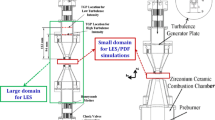Abstract
With the increased application of large eddy simulation techniques, the generation of realistic turbulence at inflow boundaries is crucial for the accuracy of a simulation. The Control Forced Concurrent Precursor Method (CFCPM) proposed in this work combines an existing concurrent precursor method and a mean flow forcing method with a new extension of the controlled forcing method to impose turbulent inflow boundary conditions primarily, although not exclusively, for domains that require periodic boundary conditions. Turbulent inflow boundary conditions are imposed through a region of body forces added to the momentum equations of the main simulation that transfers the precursor simulation into the main domain. Controlled forcing planes, which come into play as body forces added to the momentum equations on planes perpendicular to the flow, located in the precursor simulation, allow for specific Reynolds stress tensors and mean velocities to be imposed. The mean flow controlled forcing method only modifies the mean velocity profiles, leaving the fluctuating velocity field untouched. The proposed fluctuating flow controlled forcing methods extends the application of the original controlled forcing method to multiple fluctuating velocity components and couples their calculation in order to amplify the existing fluctuations present in the precursor flow field so that prescribed anisotropic Reynolds stress tensors can be reproduced. The new method was tested on high Reynolds number turbulent boundary layer flow over a wall-mounted cube and low Reynolds number turbulent boundary layer flow over a backward-facing step. It was found that the new extension of the controlled forcing method reduced the development time for both test cases considered here when compared to not using controlled forcing and only using the original controlled forcing method.











Similar content being viewed by others
References
Spalart, P.R.: Direct simulation of a turbulent boundary layer up to R e 𝜃 = 1410. J. Fluid Mech. 187, 61–98 (1988)
Lund, T.S., Wu, X., Squires, K.D.: Generation of turbulent inflow data for spatially-developing boundary layer simulations. J. Comput. Phys. 140, 233–258 (1998)
Xiao, F., Dianat, M., McGuirk, J.J.: An LES turbulent inflow generator using a recycling and rescaling method. Flow Turbulence Combust. 98, 663–695 (2017)
Stevens, R., Graham, J., Meneceau, C.: A concurrent precursor inflow method for Large Eddy Simulations and applications to finite length wind farms. Renew. Energy 68, 46–50 (2014)
Munters, W., Meneveau, C., Meyers, J.: Turbulent inflow precursor method with time-varying direction for Large-Eddy simulations and applications to wind farms. Boundary-Layer Meteorol. 159, 305–328 (2016)
Spille-Kohoff, A., Kaltenbach, H.-J.: Generation of turbulent inflow data with a prescribed shear-stress profile. In: Liu, C., Sakell, L., Beutner, T (eds.) Third AFOSR International Conference on DNS/LES Arlington, TX, 5-9 August 2001, in DNS/LES Progress and Challenges (2001)
Keating, A., Piomelli, U., Balaras, E., Kaltenbach, H.-J.: A priori and a posteriori tests of inflow conditions for Large-Eddy simulation. Phys. Fluids 6, 4696–4712 (2004)
Laraufie, R., Deck, S., Sagaut, P.: A dynamic forcing method for unsteady turbulent inflow conditions. J. Comput. Phys. 230, 8647–8663 (2011)
Schlüter, J.U., Pitsch, H., Moin, P.: Outflow conditions for integrated Large Eddy simulation/ reynolds-averaged Navier-Stokes simulations. AIAA J. 43, 156–164 (2005)
Bou-Zeid, E., Meneveau, C., Parlange, M.: A scale-dependent Lagrangian dynamic model for large eddy simulation of complex turbulent flows. Phys. Fluids 17, 025105 (2005)
Moeng, C.-H.: A Large-Eddy simulation model for the study of planetary boundary-layer turbulence. J. Atmos. Sci. 41, 2052–2062 (1984)
Monin, A.S., Obukhov, A.M.: Basic laws of turbulent mixing in the surface layer of the atmosphere. Tr. Akad Nauk SSSR Geofiz. Inst 24, 163–187 (1954)
Mohd-Yusof, J.: Combined immersed-boundary/B-spline methods for simulations of flow in complex geometries. Center for Turbulence Research Annual Research Briefs, pp. 317–327 (1997)
Tseng, Y., Meneveau, C., Parlange, M.: Modeling flow around bluff bodies and predicting urban dispersion using large Eddy simulation. Environ. Sci. Technol. 40, 2653–2662 (2006)
Calaf, M., Parlange, M.B., Meneveau, C.: Large eddy simulation study of scalar transport in fully developed wind-turbine array boundary layers. Phys. Fluids 23, 126603 (2011)
Sescu, A., Meneveau, C.: A control algorithm for statistically stationary large-eddy simulations of thermally stratified boundary layers. Quart. J. Roy Meteorol. Soc. 140, 2017–2022 (2014)
Butcher, J.C.: Numerical Methods for Ordinary Differential Equations. Wiley (2003)
Nikitin, N.: Spatial periodicity of spatially evolving turbulent flow caused by inflow boundary condition. Phys. Fluids 19, 091703 (2007)
Wu, X.: Inflow turbulence generation methods. Annu. Rev. Fluid Mech. 49, 23–49 (2017)
Castro, I.P., Robins, A.G.: The flow around a surface-mounted cube in uniform and turbulent streams. J. Fluid Mech. 79, part 2, 307–335 (1977)
Jovic, S., Driver, D.M.: Backward-facing step measurement at low Reynolds number, R e h = 5000. NASA Tech. Mem. 108807 (1994)
Le, H., Moin, P., Kim, J: Direct numerical simulation of turbulent flow over a backward-facing step. J. Fluid Mech. 330, 349–374 (1997)
Author information
Authors and Affiliations
Corresponding author
Ethics declarations
Conflict of interests
The authors declare that they have no conflict of interest.
Additional information
Publisher’s Note
Springer Nature remains neutral with regard to jurisdictional claims in published maps and institutional affiliations.
Rights and permissions
About this article
Cite this article
Haywood, J.S., Sescu, A. A Control Forced Concurrent Precursor Method for LES Inflow. Flow Turbulence Combust 102, 849–864 (2019). https://doi.org/10.1007/s10494-018-9986-3
Received:
Accepted:
Published:
Issue Date:
DOI: https://doi.org/10.1007/s10494-018-9986-3




